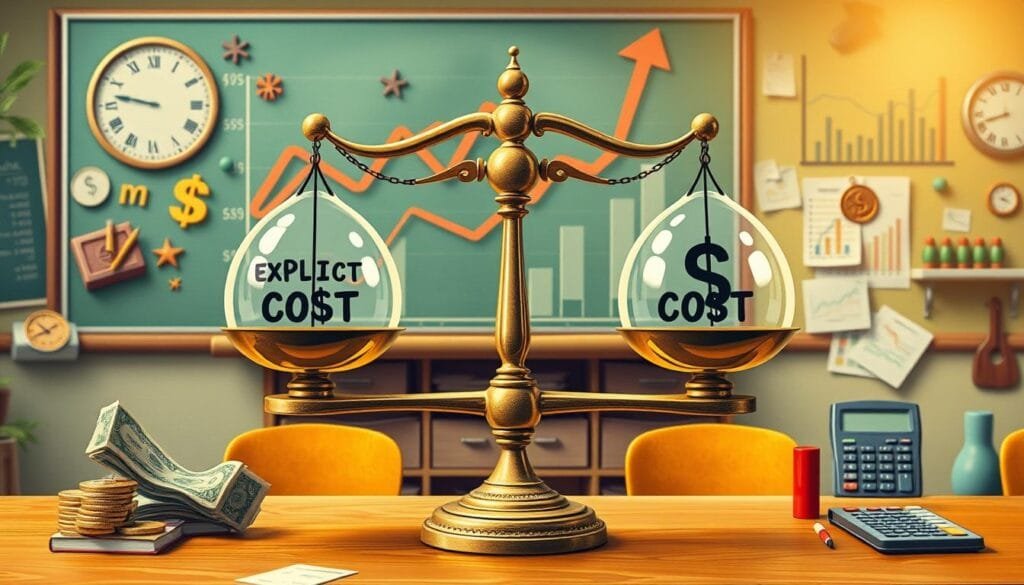Ever wondered why your business could be profitable on paper but not in reality?
Implicit costs are key but often missed in business economics. They are the cost of opportunities lost when using resources inside the company without a direct money trade. These costs don’t show up on financial statements. That’s because they’re not about real cash moving. Instead, they’re about what you give up. Economists see implicit costs as crucial for figuring out economic profit. This profit type takes away both direct costs and implicit costs from total revenue. This gives a truer picture of how profitable a company really is. Knowing about these costs helps businesses make better choices on how to use their money and resources.
Implicit costs, like not getting a salary and using employee time for other tasks, are costs of missed opportunities. These happen when we use resources without getting something definite in return. This could lead to not making money. Explicit costs are different because they involve real money exchanges and are recorded. Implicit costs, however, aren’t written down. This makes them harder to figure out and more subjective. Getting what these hidden costs really mean can change how we see economic profit and business choices.
Key Takeaways
- Implicit costs represent opportunity costs when resources are internally allocated without explicit financial exchange.
- These costs are not recorded in financial statements, making them challenging to quantify.
- Small business owners often forgo salaries, representing significant implicit costs.
- Implicit costs are essential in calculating total economic profit, accounting for indirect expenses.
- Identifying and quantifying implicit costs can improve resource allocation and financial decision-making in businesses.
Understanding Implicit Costs
Implicit costs are crucial in economics. They’re the costs of using owned assets instead of making money from them another way. Unlike explicit costs, like pay or rent, implicit costs don’t directly take cash out of your pocket.
When we calculate economic profit, we consider both implicit and explicit costs. This makes economic profit generally lower than accounting profit. Recognizing the cost of using resources is key to business strategy. Understanding implicit costs and how they differ from explicit costs is essential.
What Are Implicit Costs?
Implicit costs are about what you give up. For example, not renting out a piece of land could mean missing out on $10,000 a month. These costs show the true cost of using your own resources instead. They don’t show up on income statements. Yet, they heavily influence financial choices.
Implicit Costs vs. Explicit Costs
Distinguishing between implicit and explicit costs is fundamental for business decisions. Explicit costs are visible like rent and salaries. They hit the cash flow directly and are easy to track. Implicit costs are hidden, like lost income from not renting out a building. They impact economic profit without appearing in the accounting books.
Consider an example: Investing $40,000 could either return $10,000 from a project or $3,200 (8%) from a financial asset. The implicit cost here is the $3,200 you lose by not choosing the financial asset. This shows how implicit costs inform better resource use, aiming to maximize what you get from your assets.
Grasping both implicit and explicit costs helps companies make smart, well-rounded choices. These decisions affect long-term success and sustainability.
Examples of Implicit Costs
Implicit costs are like hidden expenses in business. They are very important in shaping business decisions and how finances are reported. These costs are not about money but still have a big impact.
Opportunity Costs
Opportunity costs show how businesses miss out on other benefits. For example, not taking a salary to reinvest in the business is an implicit cost. This could add up to $120,000 over two years, which is $60,000 a year. Using company property instead of renting it out also shows opportunity costs.

When a business owner spends time managing their business instead of working elsewhere, it’s another implicit cost. This lost wage opportunity affects the business’s profits a lot.
Non-cash Expenses
Implicit costs also include things like depreciation of goods. These are not direct payments like rent or salaries but still lower profits. For instance, not renting out machinery you own is a way implicit costs work. It’s about lost rent income and depreciation.
Another key point is losing interest income by using money in business operations. It’s crucial to understand these costs for smart resource use in a company.
Real-life Scenarios
In real life, businesses often deal with implicit costs. Training new employees is an implicit cost because it takes time away from productive work. Plus, inefficient processes can cause lost profits. These costs are important for better business operations.
Owners using their personal skills for their company instead of elsewhere is an implicit cost. Other examples include depreciation, possible reputation loss, and how non-money costs affect choices.
To further illustrate, we can compare explicit and implicit costs:
| Explicit Costs | Implicit Costs |
|---|---|
| Cost of Goods Sold: $10,000 | Forgone Salary: $60,000/year |
| Rent: $1,000 | Depreciation of Machinery |
| Employee Wages: $13,000 | Lost Rental Income |
| Utilities: $500 | Lost Interest Income |
| Supplies: $200 | Opportunity Cost of Employee Time |
| Insurance: $300 | Loss of Goodwill |
Understanding implicit costs helps businesses see the bigger picture. This allows them to improve profits and make smarter choices.
Why Implicit Costs Matter in Business Decisions
Consider implicit costs as crucial when making business choices for true economic gain understanding. These are costs you don’t see, like opportunity costs. Think of the earnings an entrepreneur misses out on by choosing one path over another. Knowing these costs helps businesses fully assess their profitability.
Fred, who owns a law firm, might think he’s making $115,000. But he’s not considering the $125,000 salary he’s foregoing. This is an implicit cost. So, his real profit is a loss of $10,000. This shows why considering all costs, seen and unseen, is vital for accurate financial health checks.
Implicit costs also matter in cost-benefit analyses. For a bakery making $100,000 with direct costs of $40,000, the apparent profit looks good. Yet, when you factor in $50,000 of implicit costs for things like rent and a potential manager’s salary, the real profit shrinks to $10,000. By including these costs, we get a fuller financial picture.

Most U.S. firms are small, with 79.2% having fewer than ten employees. For these small enterprises, overlooking implicit costs could mean trouble. Regardless of the industry, incorporating these costs is key. It makes sure business choices are well-informed.
Consider a software company making half a million dollars with $200,000 in direct costs. This leads to a $300,000 accounting profit. Yet, when you add the $250,000 in implicit costs, the real profit drops to $50,000. This highlights how vital detailed cost analysis is for long-term success.
| Types of Firms | Percentage of Firms | Number of Employees | Percentage of Total Employment |
|---|---|---|---|
| 0-9 employees | 79.2% | 12.3 million | 11.0% |
| 10-19 employees | 10.8% | 8.3 million | 7.4% |
| 20-99 employees | 8.3% | 18.6 million | 16.6% |
| 100-499 employees | 1.4% | 15.9 million | 14.2% |
| 500 or more employees | 0.30% | 50.9 million | 49.8% |
Not considering implicit costs can lead to thinking you’re more profitable than you are. Acknowledging them ensures decisions are based on a full financial understanding. This approach builds stronger and more competitive businesses.
How Implicit Costs Impact Economic Profit
It’s key to comprehend all business costs to calculate economic profit right. Implicit costs don’t show up in records, yet they still affect profits. Looking at both explicit and implicit costs gives a clearer look at a firm’s profitability.

Calculating Economic Profit
To figure out economic profit, we consider explicit and implicit costs. Direct expenses, like wages and rent, are explicit costs. But implicit costs cover what you miss out on, like the income the business owner foregoes. Here’s how to calculate it:
Economic Profit = Total Revenue – Total Explicit Costs – Total Implicit Costs
| Business Type | Generated Revenue | Explicit Costs | Implicit Costs | Accounting Profit | Economic Profit |
|---|---|---|---|---|---|
| Bakery | $100,000 | $40,000 | $50,000 | $60,000 | $10,000 |
| Software Company | $500,000 | $200,000 | $250,000 | $300,000 | $50,000 |
Distinguishing Accounting Profit from Economic Profit
Understanding the difference between accounting profit and economic profit is critical. Accounting profit doesn’t include implicit costs, which matter for taxes and basic analysis. But, economic profit factors in both explicit and implicit costs for a full view.
If a business shows positive economic profit, it’s doing more than covering costs, even considering what you could have made otherwise. Negative economic profit? It might be time to rethink how resources are used. This insight guides resource distribution and future investments.
Including all costs in profitability analyses prevents overestimating profit. This approach ensures sound investment choices by revealing true economic profit. Hence, it boosts the company’s financial strategy.
Step-by-Step Guide: How to Calculate Implicit Cost Economics
Knowing how to work out implicit costs matters a lot for businesses wanting to up their economic gain. We’ll look into spotting opportunity costs, rounding up the needed data, and using the economic profit formula.
Identifying Opportunity Costs
First off, finding opportunity costs means figuring out the value of the next best way to use resources. Take Fred’s case as an example. Here, his implicit cost comes from the income he’s missing out on from his usual corporate job, which is $125,000 each year.
Gathering Necessary Data
Now, it’s key to gather all the numbers we need. We need to fully grasp the present spending of resources as well as chances out in the market. Let’s think about Fred’s legal office:
- Expected annual earnings: $200,000
- Explicit costs (Office rental: $50,000 + Law clerk’s salary: $35,000): $85,000
- Current salary from the corporate law firm: $125,000
Collecting data right makes sure we get all the costs down pat when figuring out implicit costs.
Applying the Economic Profit Formula
To wrap up, using the economic profit formula lets us take out both clear and hidden costs from the total income. For Fred’s legal business, we work out the economic profit like this:
| Item | Cost/Revenue |
|---|---|
| Expected Annual Earnings | $200,000 |
| Total Explicit Costs | $85,000 |
| Implicit Costs (Lost Salary) | $125,000 |
| Economic Profit | -$10,000 |
This careful step-by-step way helps make sure we get the numbers right. It boosts financial checks and planning. By going through opportunity costs, data, and the economic profit formula in order, businesses get a true picture of their financial health.
Common Mistakes to Avoid When Calculating Implicit Costs
It’s key to get implicit costs right for true economic insight. Yet, many miss the mark. A big error is overlooking non-cash expenses, such as the worth of time spent on projects. Imagine a business owner works ten hours on something, with an hourly rate of $50. That’s a huge missed $500.
Not updating opportunity costs as the market changes is another major mistake. Take a business project once valued for 15% returns, now worth 20%. Not adjusting figures can mess up financial estimates. This mistake can badly affect decisions and financial health.
To dodge these pitfalls, ongoing education on cost calculations is vital. Teams must grasp the full scope of non-cash expenses. These include potential earnings from renting out property or how much assets depreciate. A company using an old machine needs to figure in its declining value.
Getting a handle on both implicit and explicit costs avoids poor choices. Companies must understand these details to boost efficiency and profits. It’s critical to accurately add up implicit costs. This includes valuing personal funds or using personal assets. This way, businesses won’t overlook important economic details.
We recommend adopting these business finance tips:
- Regularly review and update opportunity costs.
- Train financial teams on the importance and calculation of implicit costs.
- Consider both non-cash expenses and foregone income in all economic calculations.
Below is a comparison table showcasing how different forms of implicit costs can manifest within a business:
| Type of Cost | Example | Impact |
|---|---|---|
| Opportunity Cost | Foregone rent from a personal property | Potential income missed |
| Time Invested | 10 hours spent on an internal task | Loss of $500 revenue generating opportunities |
| Depreciation | Using an older machine | Asset value diminution |
| Imputed Interest | Personal funds used instead of a loan | Missed interest income |
Conclusion
In the world of business, managing costs well is a must. It’s crucial to understand and figure out implicit costs. These affect a company’s profit big time. We can better grasp our financial state by looking at both accounting and economic profit.
Implicit costs are about the non-money sacrifices when we use what we already have. They are key for improving our financial strategy. Take Eryn’s case as an example. She opened a new practice. Despite an accounting profit of $115,000, leaving her job with a salary of $125,000 meant an economic loss of $10,000 a year. This shows why we must look at all costs in business choices.
Also, a fast-food business owner looked into the hidden costs of labor and land. At first, these costs led to a loss of $2,500. But, after tweaking the numbers, they showed a $5,000 economic gain. It proves that getting our implicit cost numbers right is very important.
Platforms like the Corporate Finance Institute offer tools and info to help us. This can improve how we handle these costs.
To sum up, factoring in all costs, seen and unseen, betters our decision-making. It helps us use our resources smarter and stay ahead in the market. This way of handling costs is crucial for lasting success and growth in today’s fast-paced business scene.
FAQ
What Are Implicit Costs?
Implicit costs are like the unseen expenses in a business. They are the costs of using your resources internally, without getting paid directly. These costs are essential for figuring out your real profit and making smart decisions for your business.
How Do Implicit Costs Differ from Explicit Costs?
Unlike explicit costs, implicit costs don’t involve actual money changing hands. They aren’t shown in your financial reports. Explicit costs, on the other hand, are straight out of your bank account and record things like rent payments and salaries. Both types are vital for understanding your true profit, but only explicit costs show up in your financials.
What Are Some Examples of Implicit Costs?
Think about a business owner who decides not to take a salary to put more money into their business. Or using a property you own instead of renting it out for extra income. These are choices that might cost you potential earnings elsewhere. They show what you give up by picking one option over another.
Why Are Implicit Costs Important for Business Decisions?
Knowing about implicit costs helps businesses see the full picture of what they’re really earning. This complete understanding aids in better planning, using resources wisely, and setting up for success in the long run. They’re key to knowing the real cost of how you run your business.
How Do Implicit Costs Impact Economic Profit?
When you calculate economic profit, you take away both implicit and explicit costs from your total income. This approach gives you a clearer view of your profit, more than just looking at the numbers in your accounting reports. It’s about seeing the whole profit picture.
How Can Businesses Identify Opportunity Costs?
To figure out opportunity costs, businesses must look at the best alternate ways to use their resources. It’s about understanding how you’re currently using what you have and seeing what else is out there. This helps in making accurate opportunity cost calculations.
What Is the Economic Profit Formula?
The formula for economic profit takes away both your out-of-pocket and unseen costs from your total earnings. It’s a way to really understand what your company is making, beyond just the basic numbers.
What Are Common Mistakes in Calculating Implicit Costs?
People often miss counting those costs that don’t show up directly as cash spent. Not keeping the value of opportunity costs up to date as the market changes is another error. Regular training and reviews are critical to avoid these slips and make sure costs are figured right.
